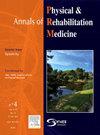A custom-made sling to achieve personal goals in shoulder pain or subluxation in the subacute stroke phase: a pilot study
IF 4.6
3区 医学
Q1 REHABILITATION
Annals of Physical and Rehabilitation Medicine
Pub Date : 2025-08-21
DOI:10.1016/j.rehab.2025.102014
引用次数: 0
Abstract
Background
The efficacy of the different shoulder orthoses available to prevent hemiplegic shoulder complications still remains debatable.
Objectives
To evaluate how wearing a custom-made (CM) shoulder sling affected personal goals and complications among hemiplegic stroke patients undergoing realworld rehabilitation.
Methods
A prospective, single-center, non-randomized, pilot study on patients having a stroke within the last 6 months with hemiplegic shoulder pain/subluxation >5 mm. The primary outcome was achievement in three personal goals according to Goal Attainment Scaling one month after (week 5) compared to before (day 7) sling wearing.
Results
Twenty-two patients were included: 60 % male, 56.4 ± 12.1 years old. ≥1 goal was achieved by 90.5 % of patients after sling wearing (week 5) versus 36 % of patients before. VAS pain score (-1.3 ± 2.3; p = 0.01) and subluxation distance (-0.41±0.42 cm; p = 0.0001) were reduced at week 5. Both the Chedoke Arm and Hand Activity Inventory score (+9.0 ± 13.1; p = 0.0003) and Fugl-Meyer upper-extremity score (+9.5 ± 9.5; p = 0.00002) were improved after sling wearing.
Conclusion
We observed improvements in patient-desired outcomes, complications, and upper-limb functional recovery after CM sling wearing for 1-month.
Trial registration
NCT04028999.
一种定制的吊带实现亚急性中风阶段肩部疼痛或半脱位的个人目标:一项试点研究
背景:不同的肩部矫形器在预防偏瘫肩关节并发症方面的效果仍然存在争议。目的评价佩戴定制肩带对接受现实康复的偏瘫脑卒中患者的个人目标和并发症的影响。方法一项前瞻性、单中心、非随机、试点研究,研究对象为过去6个月内卒中并偏瘫肩关节疼痛/半脱位5mm的患者。主要结果是与佩戴吊带前(第7天)相比,在佩戴吊带一个月后(第5周)根据目标实现量表实现三个个人目标。结果共纳入22例患者,男性占60%,年龄56.4±12.1岁。佩戴吊带后(第5周)90.5%的患者达到≥1个目标,而佩戴吊带前的这一比例为36%。VAS疼痛评分(-1.3±2.3;p = 0.01)和半脱位距离(-0.41±0.42 cm; p = 0.0001)在第5周降低。Chedoke手臂和手活动量表评分(+9.0±13.1,p = 0.0003)和Fugl-Meyer上肢评分(+9.5±9.5,p = 0.00002)均改善。结论CM吊带佩戴1个月后,患者期望的结果、并发症和上肢功能恢复均有改善。registrationNCT04028999审判。
本文章由计算机程序翻译,如有差异,请以英文原文为准。
求助全文
约1分钟内获得全文
求助全文
来源期刊

Annals of Physical and Rehabilitation Medicine
Medicine-Rehabilitation
CiteScore
7.80
自引率
4.30%
发文量
136
审稿时长
34 days
期刊介绍:
Annals of Physical and Rehabilitation Medicine covers all areas of Rehabilitation and Physical Medicine; such as: methods of evaluation of motor, sensory, cognitive and visceral impairments; acute and chronic musculoskeletal disorders and pain; disabilities in adult and children ; processes of rehabilitation in orthopaedic, rhumatological, neurological, cardiovascular, pulmonary and urological diseases.
 求助内容:
求助内容: 应助结果提醒方式:
应助结果提醒方式:


